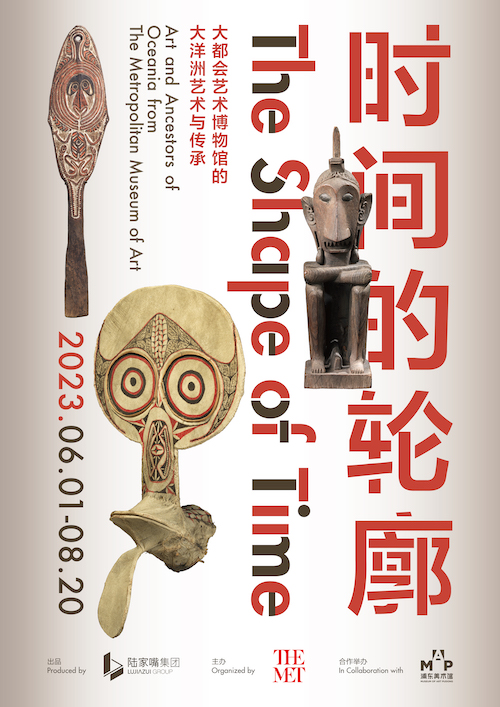
 Press Center
Press Center
On June 1, 2023, the Museum of Art Pudong is proud to unveil The Shape of Time: Art and Ancestors of Oceania from The Metropolitan Museum of Art, a highly anticipated major exhibition organized in collaboration with The Metropolitan Museum of Art, New York. The exhibition features about 110 pieces/groups of artworks that were created by generations of artists working within the past four centuries. All are incredible masterpieces from The Metropolitan Museum of Art’s renowned collection. The exhibition is on until August 20, only for a very precious period of about two and a half months. Also, this project represents the first time that an exhibition from The Metropolitan Museum of Art has made its historic debut in Shanghai, China. The exhibition is produced by the Lujiazui Development (Group) Co., Ltd., and co-organized by The Metropolitan Museum of Art and the Museum of Art Pudong.
“This breathtaking exhibition presents outstanding treasures from The Met’s internationally renowned Oceanic art collection,” said Max Hollein, Marina Kellen French Director of The Metropolitan Museum of Art. “Through an extraordinary range of monumental sculpture, ceremonial masks, and regalia from the vibrant island cultures of Oceania, the show presents awe-inspiring artistic diversity through Indigenous perspectives and new scholarship, all brilliantly curated by The Met’s Curator for Oceanic Art, Maia Nuku. We are honored to share this special touring exhibition at the Museum of Art Pudong, where it will surely serve as a profound source of inspiration for all.”
Art as a bridge between past and future
In Oceania, art represents the power of connection, creating relationships of all kinds, acting as a bridge to ancestral realms and giving shape and form to life in Oceania. The ocean and its spiritual waterways relate closely to the notion of time. The waves of the sea carry the Oceanian ancestors and their present-day descendants across time and space, unifying generations of Islanders who are linked by common ancestry. Harvesting a multitude of materials from island environments such as wood, bark, fiber, shell and bone, artists in Oceania tell a multitude of stories relating to origins, ancestral power, ceremonial knowledge and performance. Assembling these into magnificent artworks that were danced, worn, performed and displayed, islanders sought to manipulate time as a way to connect with ancestors, blending and fusing the “now” together with the “past” and “future” to great dynamic effect.
The Shape of Time, located on the third floor of the Museum of Art Pudong, is divided into three main sections: Voyaging, Ancestors and Time, which are further categorized into seven sub-sections. Organized according to different island groups, a plethora of fascinating works of art in this exhibition explores the long-standing connections between islands as well as the unique relationships that the indigenous peoples of the Pacific share with their ancestors and the ocean environment that surrounds them.
Section I centers around the concept of voyaging in both of its literal and spiritual sense, introducing the idea of artworks as vessels. The canoes and vessels that once carried the ancestors of Austronesian-speaking peoples into the region assist in their continual traversing through space and time—connecting the past with the present. Throughout the region, these early voyages are recalled in oral histories and traditions with the canoe itself a powerful metaphor for the clan or community binding many generations together.
Section II stems from Papua New Guinea and its surrounding regions, showcasing many complex ritual artworks that have been traditionally stored inside the large-scale and elaborate ceremonial houses at the heart of communities. These artworks are designed to connect the living communities with their ancestors, while the ceremonial houses themselves are understood to be the embodiment of founding ancestors, “hot” with the spiritual charge of their forbears.
The third and last section of the exhibition demonstrates the vitality of art in the region, which remains vibrant and active. In a dramatic finale to the exhibition, visually dynamic artworks explore the way art is deployed by the peoples of Oceania to manipulate time, ensuring it unfolds in the present so that the wisdom, influence, and knowledge of ancestral times are brought to bear in present-day life.
Highlights of the exhibition include drums carved from the hollowed trunk of a single tree; a dazzling turtle shell mask from the Torres Strait Islands; a ceremonial shield and complex fiber works along with exquisitely carved canoe prows, breastplates and textiles. These spectacular artworks join the past, present and future of Oceania, together constructing a kaleidoscope of diverse cultures that represent the cultural essence of this immense and dynamic region.
The title of this exhibition responds to George Kubler’s book The Shape of Time: Remarks on the History of Things, published by Yale University Press in 1962. Kubler’s notion of a plural present is of particularly relevance today. The exhibition The Shape of Time dives deeper into some of the same conceptual concerns by evaluating the material qualities of time through the lens of Oceanic art. How do Pacific Islanders think about time? How is it that the formal qualities of things, whether woven, modeled, polished, or painted, can bring the past unfolding into the present? Furthermore, where exactly do objects begin and end? The exhibition represents the diversity and openness of ideas, and aims to create a space for reflection, to see and better understand our connection to other peoples, their art, history and culture.
Oceanic narratives
Among the world's seven continents, the unique geography and culture of Oceania comprises a dramatically distinct narrative than that of others. It is the “smallest” continent on earth—with a land area of only about 8.97 million square kilometers, about 6% of the world's total land area and mostly made up of islands scattered across the Pacific Ocean. Vast and expansive, the Pacific Ocean is the largest and deepest ocean on the planet—spanning almost one third of the globe with landmasses that stretch from Australia and Papua New Guinea to the archipelagos of the north, central, and eastern Pacific.
It is the ocean that has defined the past and future identity of the people of the Oceania. The Ocean Navigators who cast their vessels across the island straits of Southeast Asia some 3,500 to 5,000 years ago, bridged a passage to the northern coastline of Papua New Guinea and traversed eastward to settle its coastal archipelagos. The defining feature of their world was a fluid and dynamic oceanscape—teeming with rich, nutritious marine life by day and glittering with constellations of stars by night. For islanders who live in the region, the ocean itself is a deeply interconnected highway—one that links and joins communities, rather than separates them. And it weaves them into a vibrant web of exchange and encounter. The trail of ancient sea-routes span across time and space, along which the islands are the paving stones. As in the poem shown near the end of the exhibition written by the renowned Pacific scholar, poet, and anthropologist Epeli Hau'ofa, “Oceania is vast, Oceania is expanding…rising from the depths of brine and regions of fire deeper still, Oceania is us. We are the sea. we are the ocean.”
First voyage of The Metropolitan Museum of Art's Oceania collection
As the largest art museum in the United States, The Metropolitan Museum of Art in New York boasts an encyclopedic collection of art from around the world, spanning more than 5,000 years. The founding of its Oceanic art collection dates to the 20th century and has deep ties to the famous Rockefeller family. Nelson A. Rockefeller, a third-generation Rockefeller heir and a prominent American statesman, devoted his life to advocating for the arts of Africa, Latin America and the Pacific. In 1969, he announced his decision to transfer over 3,000 works of art in his collection as a gift to The Metropolitan Museum of Art, which symbolized the formal establishment of the Museum's collection of Oceanic art. Since then, The Museum has continued to add to the collection, incorporating artworks in a wide range of media, such as textiles. While expanding the size of the collection, it has also continued to upgrade the architectural structure of its Wing and refreshed the narratives presented in its galleries. In 1982, The Michael C. Rockefeller Wing of The Metropolitan Museum of Art, named in honor of Nelson A. Rockefeller's son, officially opened its doors. Along with the architectural renovation, the collection of Oceanic art newly located within the Wing also became open to the public. In the years that followed, the collection has continued to grow, becoming more extensive following a range of significant acquisitions. Today, The Metropolitan Museum of Art's collection of Oceanic art stewards over 2,800 precious works that encompass the art and culture of the many and varied islands and archipelagoes of the Pacific, reflecting the dynamic cultures and rich history of this unique region alongside its wealth of innovative artistic expression in local customary arts.
The Metropolitan Museum of Art's collection of Oceanic art has not left New York since it was incorporated into the Museum’s permanent collection. As the Michael C. Rockefeller Wing is currently undergoing renovation, the Museum of Art Pudong has sought out this rare opportunity to host the collection whilst it travels from the Metropolitan Museum of Art for the first time in nearly half a century. Meanwhile, it is proud to become the first destination for this historic voyage. Max Hollein, Director of The Metropolitan Museum of Art, will also attend the opening of the exhibition to witness the collection embarking on a brand-new journey.
The exhibition The Shape of Time, curated Dr. Maia Nuku, Evelyn A. J. Hall and John A. Friede Curator for Oceanic Art at The Metropolitan Museum of Art, creates an opportunity to combine indigenous perspectives with groundbreaking, pioneering scholarship. As she says, “We hope you enjoy this once in a lifetime exhibition. We hope it inspires you to reflect on our own kinship with nature and the environment today—and the crucial relationships we each have with the land and oceans that, now more than ever, require our urgent stewardship.” As the first international stop for the touring exhibition The Shape of Time, the Museum of Art Pudong will inject new vitality into the story of Oceanic art in the 21st century.
【The Shape of Time: Art and Ancestors of Oceania from The Metropolitan Museum of Art Exhibition Poster】

About Museum of Art Pudong
Located at the heart of Xiao Lujiazui, the Museum of Art Pudong (MAP) broke ground on September 26, 2017, and opened to the public in July, 2021. Invested, built, and managed by the Lujiazui (Group) Co., Ltd. and designed by Ateliers Jean Nouvel (AJN), MAP is primarily set out to present world-class exhibitions to its audience as well as showcasing domestic artists. The four major functions of MAP include: to hold exhibitions, to promote art education, to develop cultural merchandises, and to advocate for international exchange. MAP aims to become a new cultural landmark of Shanghai and an important platform for international cultural exchange.
About The Metropolitan Museum of Art
The Metropolitan Museum of Art was founded in 1870 by a group of American citizens—businessmen and financiers as well as leading artists and thinkers of the day—who wanted to create a museum to bring art and art education to the American people. Today, The Met displays tens of thousands of objects covering 5,000 years of art from around the world for everyone to experience and enjoy. The Museum lives in two iconic sites in New York City—The Met Fifth Avenue and The Met Cloisters. Millions of people also take part in The Met experience online. Since its founding, The Met has always aspired to be more than a treasury of rare and beautiful objects. Every day, art comes alive in the Museum’s galleries and through its exhibitions and events, revealing both new ideas and unexpected connections across time and across cultures.
 PREV
PREV

 沪公网安备 31011502017932号
沪公网安备 31011502017932号



